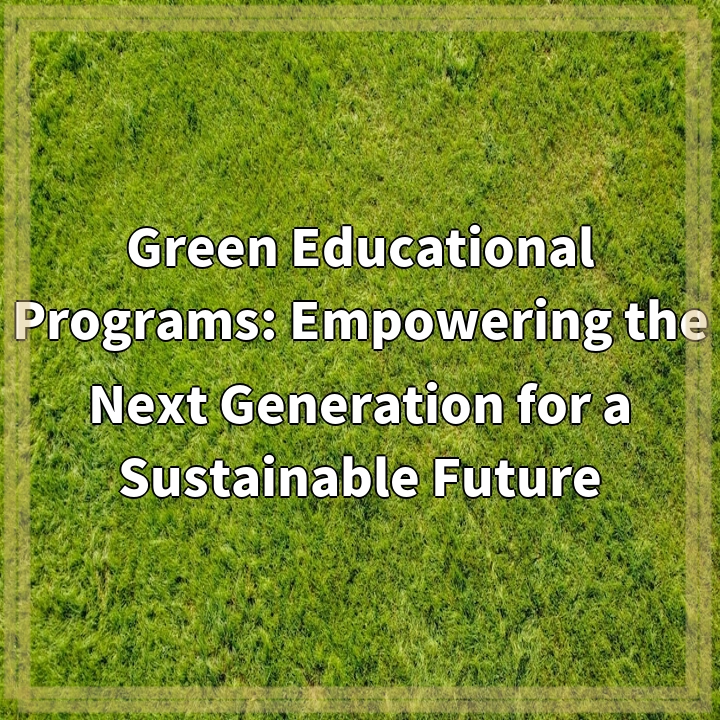
What are Green Educational Programs?
Green educational programs are initiatives aimed at providing students with knowledge, skills, and opportunities to learn about environmental sustainability. These programs focus on incorporating sustainability principles and practices into various aspects of education, from elementary schools to universities. By integrating environmental topics into their curriculum and offering hands-on experiential learning opportunities, green educational programs aim to empower the next generation in becoming environmentally conscious and responsible individuals.
Real-World Problems Associated with Green Educational Programs
While green educational programs contribute significantly to promoting environmental awareness and action, they do face certain challenges and obstacles that need to be addressed. Some of the real-world problems associated with these programs include:
Lack of Funding:
One of the major hurdles faced by green educational programs is the lack of sufficient funding. Implementing sustainability education requires resources for training educators, developing relevant teaching materials, and organizing field trips or other practical activities. Limited funding can hinder the growth and effectiveness of these programs, making it essential to explore alternative sources of funding or advocate for increased investment in environmental education.
Inadequate Teacher Training:
For green educational programs to flourish, it is crucial that teachers are equipped with the necessary knowledge and skills to effectively deliver environmental education. However, many educators may not have received adequate training in sustainability concepts or may feel less confident teaching environmental topics. Providing professional development opportunities and support for educators to enhance their understanding of sustainability can help overcome this challenge.
Lack of Integration within Existing Curriculum:
Another issue faced by green educational programs is the struggle to fully integrate environmental topics into the existing curriculum. The pressure to cover mandated subjects and meet standardized testing requirements often leaves limited space for comprehensive sustainability education. It is important to find ways to align environmental concepts with different subjects and emphasize the interdisciplinary nature of sustainability to ensure its integration across the curriculum.
Engaging Students beyond the Classroom:
While classroom-based learning forms an essential part of green educational programs, there is a need to engage students beyond traditional educational settings. Encouraging participation in environmental projects, community initiatives, and outdoor activities can help foster a deeper connection with nature and strengthen the students’ commitment to environmental stewardship. Finding opportunities for hands-on, practical experiences outside the classroom can enhance the impact and effectiveness of green educational programs.
In conclusion, green educational programs play a vital role in nurturing environmentally conscious individuals and promoting sustainable practices. Acknowledging and addressing the real-world problems associated with these programs, such as funding, teacher training, curriculum integration, and student engagement, is key to their success in empowering the next generation for a sustainable future.

Solutions for Green Educational Programs
To overcome the challenges faced by green educational programs, several solutions can be implemented:
Increased Funding:
Advocating for increased funding for green educational programs is crucial to ensure their success and sustainability. This can be done by engaging with policymakers, businesses, and community organizations that prioritize environmental education. Additionally, seeking grants and partnerships with environmentally-focused organizations can help secure the necessary resources.
Teacher Training and Support:
Providing comprehensive training and ongoing support for educators is essential to enhance their knowledge and confidence in delivering environmental education. Professional development workshops, online courses, and mentoring programs can help teachers stay updated with the latest sustainability concepts and teaching strategies.
Integrated Curriculum Approach:
Creating a more integrated approach to curriculum development is vital for successfully incorporating environmental topics across various subjects. Collaborating with educators from different disciplines can help identify opportunities to infuse sustainability concepts into existing lesson plans. Furthermore, highlighting the connections between sustainability and other subjects can demonstrate the relevance and importance of environmental education.
Engaging Experiential Learning Opportunities:
To strengthen student engagement, green educational programs should provide experiential learning opportunities beyond the classroom. Field trips to ecological reserves, participation in community clean-up projects, and hands-on activities like gardening or renewable energy projects can deepen students’ understanding and connection with the environment.
In conclusion, by implementing these solutions, green educational programs can overcome funding limitations, improve teacher training, integrate sustainability throughout the curriculum, and provide students with meaningful experiences. These measures will contribute to empowering the next generation in creating a sustainable future.















